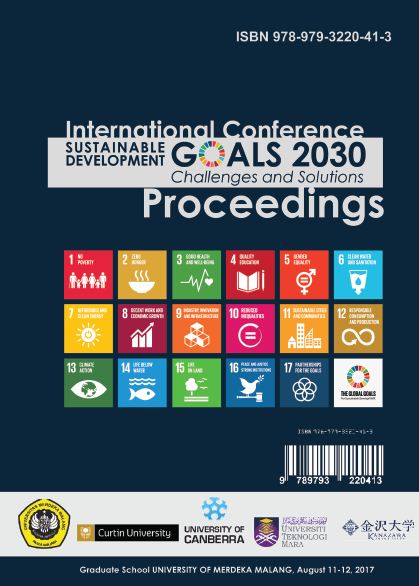Challenges of Green Open Space (Its Roles, Forms and Functions) in the Era of Sustainable Development Goals
DOI:
https://doi.org/10.26905/icgss.v1i1.1844Abstract
The acceleration of urban development in Indonesia is faced on increasingly diverse problems, especially with the conversion of land and Green Open Space (GOS) into built areas. Sustainable Development Goals (SDGs) in point 11 state about Sustainable Cities And Communities (City and Community Sustainability that build inclusive, quality, secure, resilient and sustainable cities and settlements). Therefore, affordability of access to green open space and the aspect of environmental damage is important to be observed together. Indonesian Law no. 26 of 2007 mandates 30% of the urban area tangible green space. The high intensity of changes in the use of green open space and urban land also inhibits the fulfillment of the mandate of the Act. It turns into bad implications for the environment and decreased quality of life. The integration of GOS in Urban Planning and Design in SDGs era in national scale, Government Regulation, Ministerial Regulation, provincial scale, as well as City/County Town scale in a comprehensive and sustainable manner is required, in order to maintain and improve the quality of the environment through the provision of adequate green open space. This paper is aimed to identify the roles, forms and functions of GOS in order to describe its implementation challenges.Downloads
Downloads
Published
How to Cite
Issue
Section
License
Authors who publish in this journal agree to the following terms: Proceeding of International Conference of Graduate School on Sustainability is licensed under Creative Commons Attribution-ShareAlike 4.0 International. Creative Commons Attribution-ShareAlike 4.0 International License (CC BY 4.0) is applied when mandated by research funders, such as those who have signed. Open Access articles in Jurnal Cakrawala Hukum are published under theCreative Commons Attribution-ShareAlike 4.0 International (CC BY 4.0) license. The copyright of the received article shall be assigned to the journal as the publisher of the journal. The intended copyright includes the right to publish the article in various forms (including reprints). The journal maintains the publishing rights to the published articles. Authors must agree to the copyright transfer agreement by checking the Copyright Notice column at the initial stage when submitting the article.









